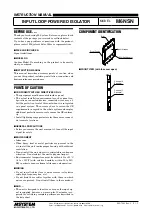
3
t
848 Airport Road, Walla Walla, Washington 99362 U.S.A.
Tel: +1 509.525.7660 / Fax: +1 509.525.7907
twigwirelesscontrols.com
1.0 InTRODUCTIOn TO nElSOn wIRElESS COnTROlS
T
he Nelson wireless control basically consists of TWIG units on valves that are operated by the
TD200 controller. It provides remote operation for up to 100 TWIGs used in connection with Nel-
son valves. In addition the TD200 provides a historical data log of the field watering events.
1.1 wIRElESS vAlvE COnTROl SySTEM COMPOnEnTS:
Two main components make the communication in the field: the TD200 controller and the TWIG field units.
The system uses the license free 900 MHz radio band to send wireless commands to TWIG units. Radio
communication is transmitting and receiving information every 20 seconds.
1.2 TwIG nETwORK ESSEnTIAlS:
Follow this guide to assure you get the right signal to the right place and have a reliable system. Watch for the
‘TWIG note’ graphic that highlights tips and suggestions.
1.2.1 CAREfUlly lOCATE ThE COnTROllER AT ThE fIElD.
The TD200 controller is the heart of the
control system. It is best to locate it near a central place so that the distance to each TWIG is minimized.
Typically, electric power is available near the pump so the TD200 is usually placed there. Antenna efficiency
improves when located at a high point so keep that in mind when choosing the controller location. The
controller cabinet is designed for outdoor use and is water resistant. However, it is a good idea to provide
some cover to help it last longer and reduce temperature and moisture aging.
1.2.2 STAy wIThIn SIGnAl RAnGE.
A common problem is to space the
TWIG units too far apart and not consider
obstructions that can block the signal. Be
sure to check the range guide in Section 7.
Weak signal strength can make a difference
in battery life. That is because a weak signal may result in failed communication requiring the controller to
frequently retry thus using more battery power. Batteries are an essential part of the system and effective
power management has been designed-in. Remember the system is two-way and the radios will have to
work harder if there are a lot of “retries” required. Keep within range to have a good, reliable system.
TWIG
note
REMEMbER TO lOCATE ThE
COnTROllER SO ThAT TwO wAy
COMMUnICATIOn IS GOOD fOR All TwIGS.
TWIG
note
OnE TD200 CAn
COnTROl UP TO
100 TwIGS.
TD200 COnTROllER
vAlvE
TwIG




































